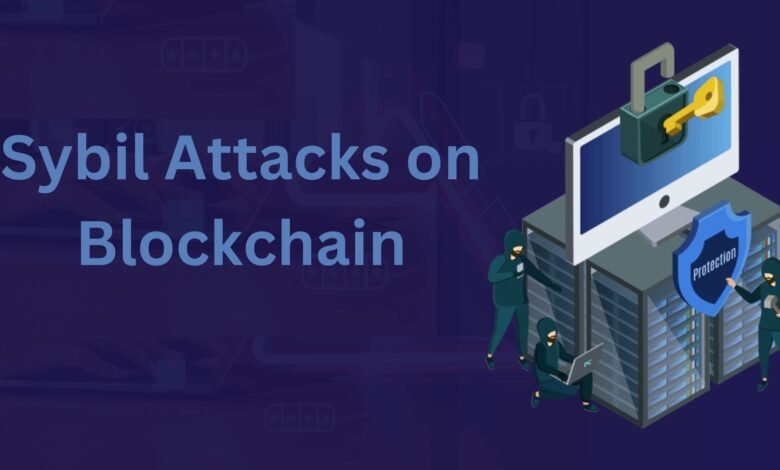
Sybil Attacks on Blockchain Numerous security concerns have arisen due to blockchain technology’s broad use, which might impact both users and the credibility of emerging projects. Blockchain technology has made a new method for exchanging information and completing financial transactions possible. Nevertheless, various security concerns have arisen due to the increasing financial worth of blockchain and Web3 projects and the widespread use of blockchain technology. Along with phishing, flash loans, and rug pull scams, the Sybil attack is among the leading instances of security vulnerabilities in blockchain.
Learning about the effects and many forms of attacks is vital to determining the best ways to resist Sybil’s assaults. Together, we may better understand the Sybil attack, its examples, and the tried-and-true techniques for warding off similar security threats.
Understanding Sybil Attacks
Sybil’s attacks on the blockchain are best understood by first defining them. In a Sybil attack, one node on a decentralized or peer-to-peer network assumes many false identities simultaneously. By seizing control of a large portion of the network’s nodes, these assaults aim to undermine the authority of a trustworthy decentralized system.
The use of false identities facilitates the acquisition of substantial control over a network. For a Sybil assault to be successful, the threat actors involved must be able to access restricted areas of the system. An example use case would be the ability of a single node or other entity to establish and manage several user or IP-based identities.
By fooling the network and other users into thinking they are authentic, the false identities amplify the effects of the Sybil assault on the blockchain. The intriguing backstory of the word “Sybil attacks” originates from a 1973 book called Sybil. Sybil, a significant character in the book, has dissociative identity disorder.
Types of Sybil Attacks
Sybil Attacks on Blockchain: A significant flaw in most blockchain-based Sybil attack prevention instructions is glossing over a crucial part of the attacks. In his study, John R. Douceur detailed the two types of Sybil attacks and how they work. There are two distinct varieties of Sybil attacks: direct and indirect. The only way to prevent these two kinds of Sybil assaults is to be aware of what they entail.
When an adversarial node communicates with legitimate nodes in the network, it engages in a direct Sybil attack. These attacks are more successful since the honest nodes cannot distinguish the two. Furthermore, malicious actors may be able to influence legitimate nodes to operate in a way that benefits themselves.
When planning to avoid Sybil assaults, it is also crucial to keep in mind the impact that indirect strikes can have. When malicious nodes communicate with legitimate ones, it’s called an indirect Sybil attack. To launch indirect assaults, hackers would use intermediary or proxy nodes instead of a direct Sybil attack.
The intermediate nodes would stand in for a single point of failure connecting the honest nodes to the Sybil node. Hackers could use the intermediary nodes to attack the honest nodes. One major drawback of indirect Sybil assaults is how difficult they are to detect compared to direct ones. Genuine nodes can be compromised once a Sybil node affects the intermediate nodes.
What are the Causes of Sybil Attacks?
Many blockchain networks have been impacted by Sybil attacks, which have become a severe security problem. Determining what causes Sybil attacks is critical to understanding blockchain assaults and how to prevent them. A security hole in the node formation procedure is the primary source of Sybil attacks. If constructing and running a node were more straightforward, any hacker might launch the attack by setting up many Sybil nodes.
Another reason Sybil attacks happen in the blockchain is an ineffective node validation scheme. The correct validation system can easily detect and resolve Sybil assaults. Nevertheless, hackers may launch a Sybil attack if they can manipulate the validation system.
Another reason blockchain networks are vulnerable to Sybil attacks is the large number of financial transactions on them. Cryptographic protocols that process many monetary transactions may thus be susceptible to Sybil attacks.
Impact of Sybil Attacks
When trying to figure out how to stop Sybil’s assaults, detection is the first and most crucial step. You can protect yourself from Sybil attacks by familiarizing yourself with the best procedures for detecting them. Having a few fictitious accounts on the blockchain might not be that big of a deal. Nevertheless, the network could be severely affected by numerous false identities. This is a rundown of how a Sybil attack may backfire.
Blocking Users from Networks
The most notable result of the Sybil attack on blockchain networks is blocking users from accessing them. Discussions about avoiding Sybil attacks in blockchain would bring to light the issues with creating false identities. In a blockchain network, phony nodes can eventually overwhelm the real ones.
Once Sybil nodes take over the network, they can alter its operations however they see fit. Above all else, Sybil nodes can reject the insertion or transmission of blocks inside a network. Consequently, the imposter node may prevent other users from joining the network. A short-term decline in cryptocurrency values caused by the hacks could harm the credibility of blockchain technologies.
Compromising the Privacy of Blockchain
The building blocks of a blockchain network, called nodes, control the data transfer inside the system. Consequently, privacy issues can arise from any compromised node type. Due to worries about privacy problems in blockchain networks, there is a growing demand for techniques to resist Sybil attacks. Sybil nodes can retrieve data regarding other network nodes.
In addition, user IP addresses that are compromised in a Sybil attack can be used to create additional bogus nodes. P2P networks are more vulnerable to privacy breaches. Hackers could utilize Sybil nodes to eavesdrop on data transfers and observe network traffic.
Network Disruption with 51% Attacks
Sybil attacks often target blockchain networks to launch a 51% attack. Looking for a 51% attack is one of the simplest ways to detect a Sybil attack. Attacks like these affect 51% of the network and use fake nodes. The other legitimate nodes in the network could have their votes trumped by the imposter Sybil nodes.
These kinds of Sybil attacks can cause issues with votes on vital operational decisions for the blockchain network. To protect hackers’ interests, the 51% attack can block transaction confirmation or the sequencing of new transactions. Another method that hackers could use to commit double spending is transaction reversal.
Examples of Sybil Attacks
A lot of trouble can be caused by Sybil attacks, as seen by their impact. Sybil attacks can breach any blockchain network. The real-world examples of blockchain assaults could teach you a lot about the many attacks and how to prevent them. Attacks on the Verge cryptocurrency protocol in 2021 are among the most well-known instances of Sybil attacks. As part of their Sybil attack, hackers restructured the blockchain network and erased transactions over 200 days.
The Sybil attack has also jeopardized the security of blockchain networks. Cryptocurrencies like Monero aim to provide users with private and secure ways to conduct transactions. Consider the 2020 breach on Monero, when a hacker compromised the network and associated IP addresses with transactions, as an example of a Sybil attack. Monero would still be helpless to block the attack from leaking users’ private information.
The 2014 Tor attack is another notable addition to the first occurrences of Sybil attacks. As the Tor attack demonstrated, peer-to-peer networks are susceptible to Sybil attacks. The Sybil assault allowed the attackers to learn where Tor users were and who they were. The fact that a single hacker could take control of about eighty-five separate relays using a single IP address is a significant point of attack. This allowed the hacker to take over the network and get sensitive data.
In 2020, Tor was hit by yet another Sybil attack on the blockchain, this time by hackers with a different goal. The attackers targeted anyone using the Tor network who had Bitcoins. After gaining control of most bogus Tor relays, the hacker intercepted users’ Bitcoin transactions. The criminal then defrauded Bitcoin holders, using the stolen information to withdraw money.
Ideal Solution for Preventing Sybil Attacks
Using a Sybil attack to hack more extensive blockchain networks like Bitcoin is more complicated. The Sybil attack protection measures, however, work with any blockchain type. You may find it challenging to cope with the fallout of Sybil’s assaults, which can include the loss of private data or cryptocurrency, and the impact can be daunting. Conversely, you can stop the attacks before they happen by taking preventive actions. These are the best ways to prevent the attacks from happening.
Developing a Reputation System
The necessity of creating a reputation system stands out as the most crucial aspect of Sybil’s blockchain attacks and mitigation strategies. The proliferation of false identities is the backbone of Sybil’s attacks. Consequently, various network members could benefit from having varying degrees of authority thanks to a reputation system.
The capacity to conduct additional interactions is typically bestowed upon users who have been active in the system for an extended duration. On the other hand, reputation systems like these are not easy to build. It shifts the burden of accountability onto the network’s users.
Older members can be verified as trustworthy nodes and granted the ability to bypass Sybil nodes through the reputation process. Reputation measures can deter attackers by discouraging them from wasting time generating new accounts and waiting for control over the network. Instead, they would move on to an easier target.
Identity Validation Mechanism
Among the most apparent effects of Sybil attacks is the potential breach of your personal information. A privacy issue cannot be fully resolved by relying on a reputation mechanism. The most efficient method for detecting Sybil attacks would focus on validating the identity of newly added nodes. A centralized authority might validate all the new nodes using identity validation procedures for direct validation. One approach could be to have already-verified nodes indirectly validate new nodes by attesting to their identities.
Social Trust Graphs
Using social trust graphs is another recommended step in the fight against Sybil’s assaults. A social trust network can function by meticulously analyzing data on the connections between its nodes. As a result, it can help spot malicious nodes and block them before they cause harm.
Find out how to avoid a Sybil assault on the blockchain by reading up on the many methods recommended by experts who have already tackled the problem. Some users rely on metrics that are based on sparsity, while other methods analyze user qualities within a topological framework.
After that, the graphs divided the network area where Sybil nodes were located, making it impossible for them to manipulate the honest nodes. Many tools, such as SybilLimit, SybilRank, and SybilGuard, are available for social trust graphs. The strongest argument favoring social trust graphs to avoid Sybil attacks is their capacity to lessen the attack’s detrimental effects.
Conclusion
Among the most dangerous blockchain security threats is the Sybil attack. Sybil attack prevention solutions should be prioritized because blockchain adoption is at risk from security threats. The most significant issue with Sybil attacks is the production of imposter nodes that pass themselves off as real ones. Users may suffer enormous financial losses in addition to potential invasions of privacy.










